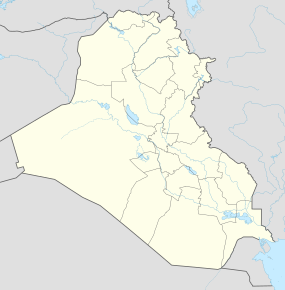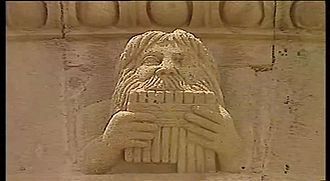Hatra
| الحضر | |

The ruins of Hatra circa 1988
|
|
| Location | Hatra District, Ninawa Governorate, Iraq |
|---|---|
| Region | Mesopotamia |
| Coordinates | 35°35′17″N 42°43′6″E / 35.58806°N 42.71833°ECoordinates: 35°35′17″N 42°43′6″E / 35.58806°N 42.71833°E |
| History | |
| Founded | 3rd or 2nd century BC |
| Abandoned | 241 AD |
| Site notes | |
| Condition | "Leveled" (status undetermined) |
| Public access | Inaccessible (in a war zone) |
| Official name | Hatra |
| Type | Cultural |
| Criteria | ii, iii, iv, vi |
| Designated | 1985 (9th session) |
| Reference no. | 277 |
| Region | Arab States |
Hatra (Arabic: الحضر al-Ḥaḍr) was an ancient city in the Ninawa Governorate and al-Jazira region of Iraq. It was known as al-Hadr, a name which appears once in ancient inscriptions,[citation needed] and it was in the ancient Persian province of Khvarvaran. The city lies 290 km (180 mi) northwest of Baghdad and 110 km (68 mi) southwest of Mosul.
On 7 March 2015, various sources including Iraqi officials reported that the militant group Islamic State of Iraq and the Levant (ISIL) had begun demolishing the ruins of Hatra.[1][2] Video released by ISIL the next month showed destruction of the monuments.[3]
Contents
History[edit]

Hatra was probably built in the 3rd or 2nd century BC by the Seleucid Empire. After its capture by the Parthian Empire, it flourished during the 1st and 2nd centuries AD as a religious and trading center.[4] Later on, the city became the capital of possibly the first Arab Kingdom in the chain of Arab cities running from Hatra, in the northeast, via Palmyra, Baalbek and Petra, in the southwest. The region controlled from Hatra was the Kingdom of Araba, a semi-autonomous buffer kingdom on the western limits of the Parthian Empire, governed by Arabian princes.
Hatra became an important fortified frontier city and withstood repeated attacks by the Roman Empire, and played an important role in the Second Parthian War. It repulsed the sieges of both Trajan (116/117) and Septimius Severus (198/199).[5] Hatra defeated the Iranians at the battle of Shahrazoor in 238, but fell to the Iranian Sassanid Empire of Shapur I in 241 and was destroyed.[5] The traditional stories of the fall of Hatra tell of an-Nadira, daughter of the King of Araba, who betrayed the city into the hands of Shapur. The story tells of how Shapur killed the king and married an-Nadira, but later had her killed also.[4]
Hatra was the best preserved and most informative example of a Parthian city. It was encircled by inner and outer walls nearly 2 kilometres (1.2 mi) in diameter[6] and supported by more than 160 towers. A temenos (τέμενος) surrounded the principal sacred buildings in the city’s centre. The temples covered some 1.2 hectares and were dominated by the Great Temple, an enormous structure with vaults and columns that once rose to 30 metres. The city was famed for its fusion of Greek, Mesopotamian, Canaanite, Aramean and Arabian pantheons, known in Aramaic as Beiṯ Ĕlāhā ("House of God"). The city had temples to Nergal (Assyrian-Babylonian and Akkadian), Hermes (Greek), Atargatis (Syro-Aramaean), Allat and Shamiyyah (Arabian) and Shamash (the Mesopotamian sun god).[4] Other deities mentioned in the Hatran Aramaic inscriptions were the Aramaean Ba'al Shamayn, and the female deity known as Ashurbel, which was perhaps the assimilation of the two deities the Assyrian god Ashur and the Babylonian Bel—despite their being individually masculine.
List of rulers[edit]
In inscriptions found at Hatra, several rulers are mentioned. Other rulers are sporadically mentioned by classical authors. They appear with two titles. The earlier rulers are called mrj´ (translation uncertain), the later ones mlk -king.
| Name | Title | Years attested | Comments |
|---|---|---|---|
| Worod | mry´ | ||
| Ma’nu | mry´ | ||
| Elkud | mry´ | AD 155/156 | |
| Nashrihab | mrj´ | AD 128/29 - 137/38 | |
| Naṣru | mry´ | 128/29 - 176/77 | |
| Wolgash I | mry´ and mlk - King | ||
| Sanatruq I | mry´ and mlk - King | AD 176/177 | ruled together with Wolgash I |
| Wolgash (II?), son of Wolgash (I.) | |||
| Abdsamiya | mlk - King | AD 192/93 - 201/202 | Supported the Roman emperor Pescennius Niger |
| Sanatruq II | mlk - King | AD 207/08 - 229/230 |
Modern Hatra[edit]
Hatra was used as the setting for the opening scene in the 1973 film The Exorcist,[7] and since 1985 is a UNESCO World Heritage Site.[8]
Saddam Hussein saw the site's Mesopotamian history as reflecting glory on himself, and sought to restore the site, and others in Ninevah, Nimrud, Ashur and Babylon, as a symbol of Arab achievement,[9] spending more than US $80 million in the first phase of restoration of Babylon. Saddam Hussein demanded that new bricks in the restoration use his name (in imitation of Nebuchadnezzar) and parts of one restored Hatra temple have Saddam's name.[10]
From 1987 the Italian Archaelogical Expedition, directed by R. Ricciardi Venco (University of Torino), is working at Hatra. The excavations were focused on an important house (Building A), located close to the Temenos, and on deep soundings in the Temenos central area. Now the Expedition is active in different projects regarding the preservation and development of the archaeological site.
In 2004, The Daily Telegraph stated "Hatra's finely preserved columns and statues make it one of the most impressive of Iraq's archaeological sites"[11]
Demolition by ISIL[edit]
Actions by the Islamic State of Iraq and the Levant, which occupied the area in mid-2014, have been a major threat to Hatra. In early 2015 they announced their intention to destroy many artifacts, claiming that such "graven images" were un-Islamic, encouraged shirk (or polytheism), and could not be permitted to exist, despite the preservation of the site for 1,400 years by various Islamic regimes. Isis militants pledged to destroy the remaining artifacts. Shortly thereafter, they released a video showing the destruction of some artifacts from Hatra.[12][13] After the bulldozing of Nimrud on March 5, 2015, "Hatra of course will be next" said Abdulamir Hamdani, an Iraqi archaeologist from Stony Brook University.[14] On March 7, Kurdish sources reported ISIS had begun the bulldozing of Hatra.[15][16][17]
UNESCO and ISESCO issued a joint statement saying “With this latest act of barbarism against Hatra, (the IS group) shows the contempt in which it holds the history and heritage of Arab people.”[18]
Gallery[edit]
See also[edit]
References[edit]
- ^ ABC news
- ^ UN News Centre
- ^ Vivian Salama (4 Apr 2015). "Video: Islamic State group shot, hammered away Iraq's Hatra". Associated Press.
- ^ a b c "Hatra". Encyclopædia Britannica. Retrieved 14 December 2013.
- ^ a b Advisory Body Evaluation on Hatra. International Council on Monuments and Sites (ICOMOS). 1985. pages 1-2.
- ^ "Hatra UNESCO World Heritage Centre". http://whc.unesco.org/en. UNESCO. 1992–2015. Retrieved 31 March 2015. External link in
|website=(help) - ^ Freeman, Colin s (25 June 2014). "Iraq's 'Exorcist' temple falls into Isis jihadist hand". The Telegraph. London. Retrieved 7 March 2015.
- ^ "Hatra". whc.unesco.org. UNESCO. Retrieved 7 March 2015.
- ^ Lawrence Rothfield (1 Aug 2009). The Rape of Mesopotamia: Behind the Looting of the Iraq Museum. University of Chicago Press.
- ^ "Ancient Hatra Ruins". Defense Video & Imagery Distribution System. 9 September 2006.
- ^ Freeman, Colin (4 January 2004). "American troops launch 'Exorcist' tour at ancient temple". The Telegraph.
- ^ Cockburn, Patrick (27 February 2015). "Iraq: Isis militants pledged to destroy remaining archaeological treasures in Nimrud". The Independent. Retrieved 8 March 2015.
- ^ "ISIL video shows destruction of 7th century artifacts". aljazeera.com. 26 February 2015. Retrieved 7 March 2015.
- ^ Karim Abou Merhi (5 March 2015). "IS 'bulldozed' ancient Assyrian city of Nimrud, Iraq says". AFP. Retrieved 5 March 2015.
- ^ "Reports: ISIS bulldozed ancient Hatra city in Mosul - RiyadhVision". RiyadhVision. 7 March 2015. Retrieved 8 March 2015.
- ^ Yacoub, Sameer N. (7 March 2015). "IS destroying another ancient archaeological site in Iraq". ArmyTimes. United States. Associated Press. Retrieved 7 March 2015.
- ^ "Islamic state 'demolish' ancient Hatra site in Iraq". BBC. 7 March 2015. Retrieved 7 March 2015.
- ^ Yacoub, Sameer N.; Salam, Vivian (7 March 2015). "IS destroying another ancient site in Iraq". The Telegraph. Macon, Georgia. Retrieved 8 March 2015.
External links[edit]
| Wikimedia Commons has media related to Hatra. |
- Between Rome and Parthia: The Desert City of Hatra
- http://lexicorient.com/e.o/hathra.htm
- http://www.britannica.com/eb/article-9039509
- http://shezaf.net/english/Video/Video/Hatra.html
- http://www.bbc.co.uk/archive/chronicle/8612.shtml BBC Chronicle "Lost Kings of the Desert"
- https://hatrasite.com/ Italian Archaeological Expedition at Hatra















